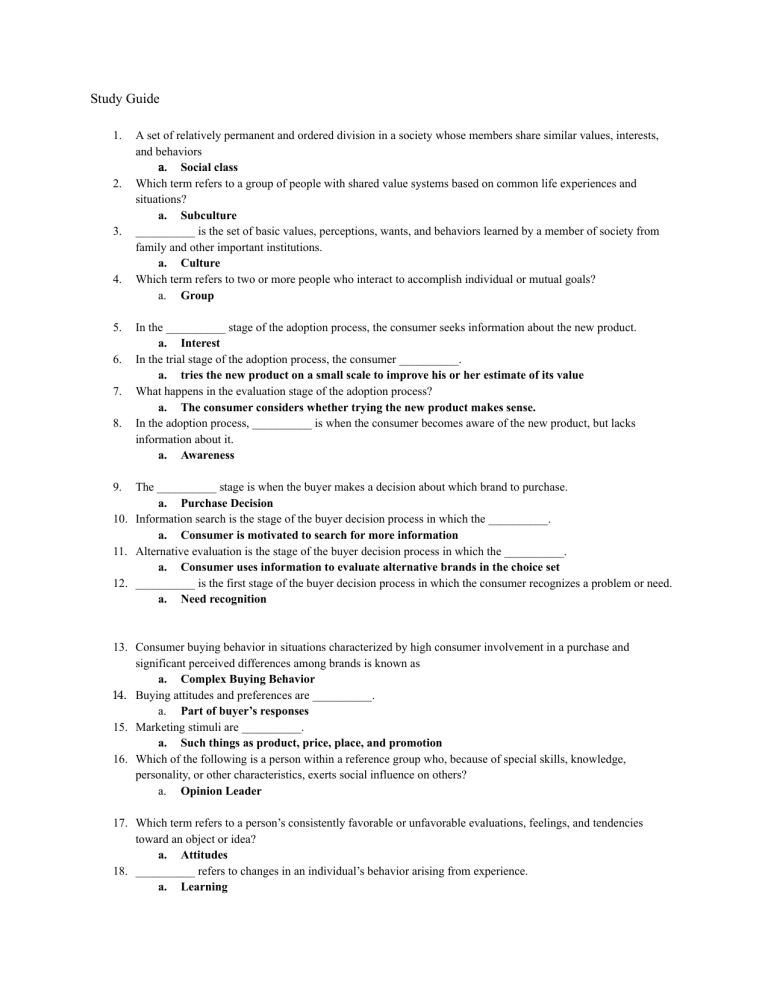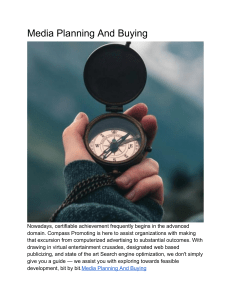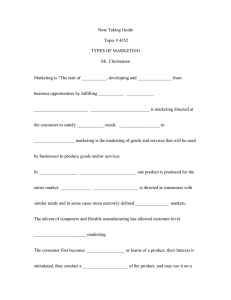
Study Guide 1. 2. 3. 4. 5. 6. 7. 8. A set of relatively permanent and ordered division in a society whose members share similar values, interests, and behaviors a. Social class Which term refers to a group of people with shared value systems based on common life experiences and situations? a. Subculture __________ is the set of basic values, perceptions, wants, and behaviors learned by a member of society from family and other important institutions. a. Culture Which term refers to two or more people who interact to accomplish individual or mutual goals? a. Group In the __________ stage of the adoption process, the consumer seeks information about the new product. a. Interest In the trial stage of the adoption process, the consumer __________. a. tries the new product on a small scale to improve his or her estimate of its value What happens in the evaluation stage of the adoption process? a. The consumer considers whether trying the new product makes sense. In the adoption process, __________ is when the consumer becomes aware of the new product, but lacks information about it. a. Awareness 9. The __________ stage is when the buyer makes a decision about which brand to purchase. a. Purchase Decision 10. Information search is the stage of the buyer decision process in which the __________. a. Consumer is motivated to search for more information 11. Alternative evaluation is the stage of the buyer decision process in which the __________. a. Consumer uses information to evaluate alternative brands in the choice set 12. __________ is the first stage of the buyer decision process in which the consumer recognizes a problem or need. a. Need recognition 13. Consumer buying behavior in situations characterized by high consumer involvement in a purchase and significant perceived differences among brands is known as a. Complex Buying Behavior 14. Buying attitudes and preferences are __________. a. Part of buyer’s responses 15. Marketing stimuli are __________. a. Such things as product, price, place, and promotion 16. Which of the following is a person within a reference group who, because of special skills, knowledge, personality, or other characteristics, exerts social influence on others? a. Opinion Leader 17. Which term refers to a person’s consistently favorable or unfavorable evaluations, feelings, and tendencies toward an object or idea? a. Attitudes 18. __________ refers to changes in an individual’s behavior arising from experience. a. Learning 19. The process by which people select, organize, and interpret information to form a meaningful picture of the world a. Perception 20. A descriptive thought that a person holds about something a. Belief 21. Factors that drive consumer behavior a. Cultural i. Class ii. Ethnicity iii. Cross-Cultural Dynamics b. Social Groups i. Family ii. Friends c. Personal Lifestyle d. Psychological Needs (Monkey Awareness) i. Mazlow’s Hierarchy of Needs (Bottom to Top) 1. Physiological Needs 2. Safety & Security 3. Group Needs 4. Esteem 5. Self Actualization 22. Types of Buying a. Complex Buying Behavior (Many Choices, Cares a Lot) i. When consumers are buying an expensive product. ii. In this infrequent transaction, consumers are highly involved in the purchase decision. iii. Consumers will research thoroughly before committing to invest. b. Dissonance Reducing Buying Behavior (Few Choices, Cares a Lot) i. Consumer involvement is very high. This might be due to high price and infrequent purchase. ii. In addition, there is a low availability of choices with less significance differences among brands. iii. In this type, a consumer buys a product that is easily available. c. Habitual Buying Behavior (Few Choices, Cares a Little) i. When consumers are buying products that they use for their daily routine, they do not put a lot of thought. ii. They either buy their favorite brand or the one that they use regularly iii. Or the one available in the store or the one that costs the least. d. Variety Seeking Buying Behavior (Many Choices, Cares a Little) i. Consumer involvement is low. ii. There are significant differences between brands. Here consumers often do a lot of brand switching. iii. The cost of switching products is low, and hence consumers might want to try out new products just out of curiosity or boredom. iv. Consumers here, generally buy different products not because of dissatisfaction but mainly with an urge to seek variety.





